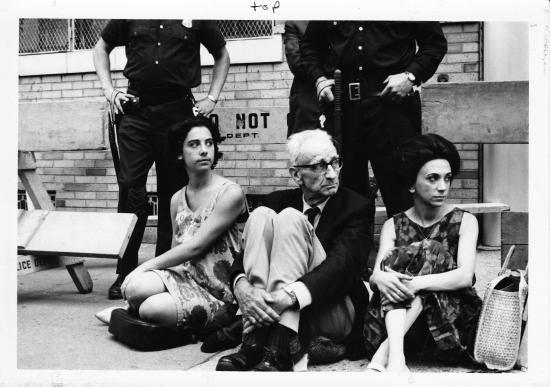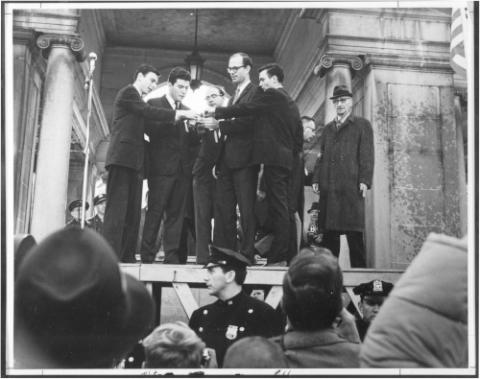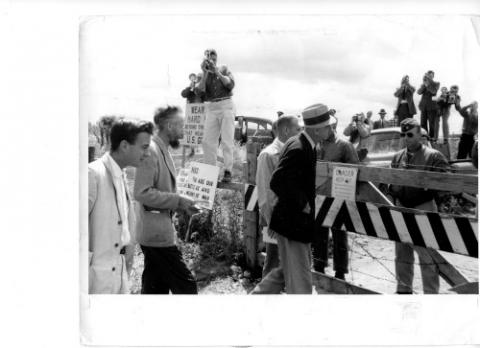
Abraham Johannes Muste, known to the public as ‘AJ Muste’, was a remarkable and in some ways enigmatic figure bridging the nineteenth and twentieth centuries.
Born in Holland on 8 January 1885, Muste was brought to the US as a child of six and raised in Grand Rapids, Michigan, by a Republican family in the strict Calvinist traditions of the Dutch Reformed Church. In 1909, he was ordained a minister in that church, and married Anna Huizenga, with whom he was to share the next 40 years and raise three children.
In the normal course of events, Muste would have lived out his life within those conservative limits, perhaps with theological distinction, but without great impact on the temporal world. His record at the time of his ordination: class valedictorian at Hope College, captain of the basketball team, a magna cum laude degree from Union Theological Seminary.
Yet, AJ soon made a decision that would begin a lifetime of carefully considered radical activism. In the 1912 presidential election, he cast his vote for the Socialist candidate, Eugene Victor Debs. In 1914, increasingly uncomfortable with the Reformed Church, he became pastor of a Congregational Church.
When war broke out in Europe, AJ became a pacifist, inspired by the Christian mysticism of the Quakers. Three years later these beliefs cost him his church. He then started working with the fledging American Civil Liberties Union in Boston, Massachusetts, and took a post with the Quakers in Providence, Rhode Island.
In 1919, when the textile industry strikers appealed for help from the religious community, he suddenly found himself thrust into the centre of the great labour strikes in Lawrence, Massachusetts.
In the early 1920s, AJ became director of the Brookwood Labour College in Katonah, New York. This school was of enormous importance in labour history; its curriculum consisted of the theory and practice of labour militancy – so much so that the American Federation of Labour (AFL, the national federation of trade unions) found Brookwood Labour College a considerable embarrassment. The young Dutch Reformed minister had become a respected – and controversial – figure in the trade union movement.
He was considered by those who worked with him to have one of the sharpest political minds in the country
For several years during the 1920s, AJ served as chair of the US branch of the Fellowship of Reconciliation, then a Christian pacifist grouping, but he steadily drifted toward revolutionary politics. In 1929, he helped form the Conference for Progressive Labour Action (CPLA), seeking to reform the AFL from within. When the Depression broke like a storm over the United States, the CPLA became openly revolutionary and was instrumental in forming the American Workers Party in 1933 – a ‘democratically organized revolutionary party’ in which AJ played the leading role.
AJ had now completed one stage of his evolution, from conservative young pastor to revolutionary Marxist. He abandoned his Christian pacifism and became an avowed Marxist- Leninist. He was a key figure in organising the sit-down strikes of the 1930s and, cooperating with James Cannon of the Trotskyist movement, he merged his own political group with Cannon’s, forming the Trotskyist ‘Workers Party of the United States’ (which later developed into the SWP).
At this point, something occurred in AJ’s life which cannot be fully explained. In 1936, troubled by certain questions regarding revolutionary activity, he took a ship to Europe, where, in Norway, he met with Leon Trotsky. He had left the US as a Marxist-Leninist, but returned that same year as a Christian pacifist.
It is not clear what caused the religious experience he had on the trip, but he was deeply changed. For the second time in his life, AJ burned his bridges behind him, although he did remain active in the labour movement, heading the Presbyterian Labour Temple on 14th Street in Manhattan, New York City. In 1940, he became executive secretary of the religious pacifist organisation, the Fellowship of Reconciliation (FoR), a post he held until 1953.
The period from 1940 to 1953 was, in its own way, as turbulent as the 1930s. It covered the war years, the beginning of the Cold War, the McCarthy period. Under AJ’s leadership, FoR stimulated the organisation of the Congress on Racial Equality (CORE), the first of the militant civil rights groups.
At the age of 68, AJ ‘retired’. The year was 1953 and, for most persons, life would have been filled with enough risk, enough drama, to permit settling into a respected twilight period. He had lived through the Depression as a major radical leader, heavily influenced the labour movement, and had opposed two world wars. He had rallied US pacifists in their darkest hours of the Second World War, defending young men who refused military service, fighting complex theological battles with those who sought to place the moral weight of Christianity at the disposal of the State.
Yet, AJ remained virtually unknown to the general public.

He was considered by those who worked with him to have one of the sharpest political minds in the country. But it was an almost perversely prophetic mind, taking him always one step beyond the point the general public – or even his followers – was prepared to go. His associates learned from him directly – from discussions, the dialogues, and actions which marked their relationships with him. He wrote several books, but he communicated – and influenced – best on a personal level.
AJ’s life after retirement was not rich with honours but with action. He continued for nearly another 20 years to trouble the society around him. He became the leader of the Committee for Non-Violent Action (CNVA), an organisation whose members sailed ships into nuclear test zones in the Pacific, hopped barbed wire fences into nuclear installations in this country, and went out in rowboats to try to block the launching of US nuclear submarines.
In 1961, a team of pacifists completed an extraordinary walk all the way from San Francisco (in the United States) to Moscow (in the Soviet Union) and, thanks largely to the diplomacy of AJ, was able to carry the message of unilateral disarmament not only to towns all across the country, but even into Moscow’s Red Square.
AJ was close to the emerging liberation movements in Africa, and helped organise the World Peace Brigade which worked closely with Kenneth Kaunda of Zambia and Julius Nyerere of Tanzania. African leaders often met first with AJ on their visits to the US – and only later with the state department. AJ served as close friend and mentor to Martin Luther King Jr and his wife, Coretta Scott King.
But it was with the onset of the Vietnam War and its fierce popular opposition that AJ entered what may have been the most active period of his life.
He alone was trusted by all the radical groups, he alone was able to act as the centre around which they could organise the vast coalition of energies which became the US movement to end that war.
In 1966, AJ led a group of pacifists to Saigon in South Vietnam where, after trying to demonstrate for peace, they were arrested and deported. Late that same year, he flew with a small team of religious leaders to Hanoi in North Vietnam, where they met with the North Vietnamese leader, Ho Chi Minh. Old men meeting in the midst of war, one of them committed to the path of violent change, the other to nonviolence.
Less than a month later, AJ died suddenly in New York City. At his death, messages of condolence came from sources as diverse as Ho Chi Minh and Robert Kennedy. Memorial services brought speakers from the church, the trade union movement, and from both the Communist and Socialist Workers parties.
To an outsider, it must have seemed incomprehensible that a single man could have so broad a range of friends. To his associates, he was a remarkably warm person, one who loved James Wilson.
To audiences, however, he seemed more distant and, while his speaking style was direct and immediate, one listener said she knew, having heard him, what the prophets sounded like. His integrity was beyond question. He tolerated disagreement but achieved remarkable loyalty.
He did not have disciples but co-workers. A brilliant thinker, he left behind no single body of theoretical work – but a small army of women and men whose lives, hearts and thinking were forever radically changed by knowing him.

There are two themes that ran through AJ Muste’s life so clearly and marked his own actions so decisively, that the conflict between them became a dialectic, never resolved.
One theme was peace, nonviolence, profound reverence for life.
The other theme was social justice.
To respect life meant to struggle to achieve social justice, yet the struggle for social justice invariably disturbed the peace and risked the nonviolence so central to AJ.
The life-destroying institutions of injustice which AJ saw around him were intolerable – yet violent social change was also intolerable. It was this ‘dialectic’ which led him into the Marxist- Leninist movement and then back into the religious pacifist movement.
Those who worked most closely with him are convinced that he was never fully able to leave behind his Christian mysticism when he was a Marxist-Leninist, and that on his return to the church he brought with him much of his Marxism.
No authentic honour can be done to the memory of the man and his life if we select one theme and ignore the other. Few people have been so deeply committed at the same time both to peace and to social justice, so fully aware of the difficulty of reconciling these two demands, and so intent on making that effort.
One of AJ Muste’s favorite selections from poetry is surely one which he earned as a final homage:
I think continually of those who were truly great...
The names of those who in their lives fought for life,
Who wore at their hearts the fire’s centre.
Born of the sun, they travelled a short while toward the sun.
And left the vivid air signed with
Stephen Spender
-----------------------
The AJ Muste Institute
For nearly 50 years, the AJ Muste Memorial Institute has supported efforts to attain racial, ethnic and gender equality, economic and environment justice, and immigrants’ and labour rights. It has aided actions aimed at curbing or ending capital punishment, the military and prison industrial complexes, and state-sponsored terrorism.
The Muste Institute provides grants, sponsorships, and educational resources to hundreds of grassroots projects around the world. It funds innovative organising, often with seed funds that give a necessary boost to bold ideas.
It also provides affordable and collaborative space to a dozen or so groups in New York City.
The Institute was established by members of the War Resisters League to offer safe space to radical organisations threatened by government surveillance
and harassment. From its start at a borrowed desk run by volunteers in lower Manhattan, New York City, the Institute gained tax-exempt status in 1974 and began raising money to help grassroots projects through grants and fiscal sponsorships. Both a shelter and a hub, the Institute has grown into a nonprofit charitable foundation for innovative organising across the US and the globe.
The Institute says on its website: ‘If you are an organisation in need of support, or a donor able to help us provide it, we welcome you to our community of undaunted activists.’ www.ajmuste.org

